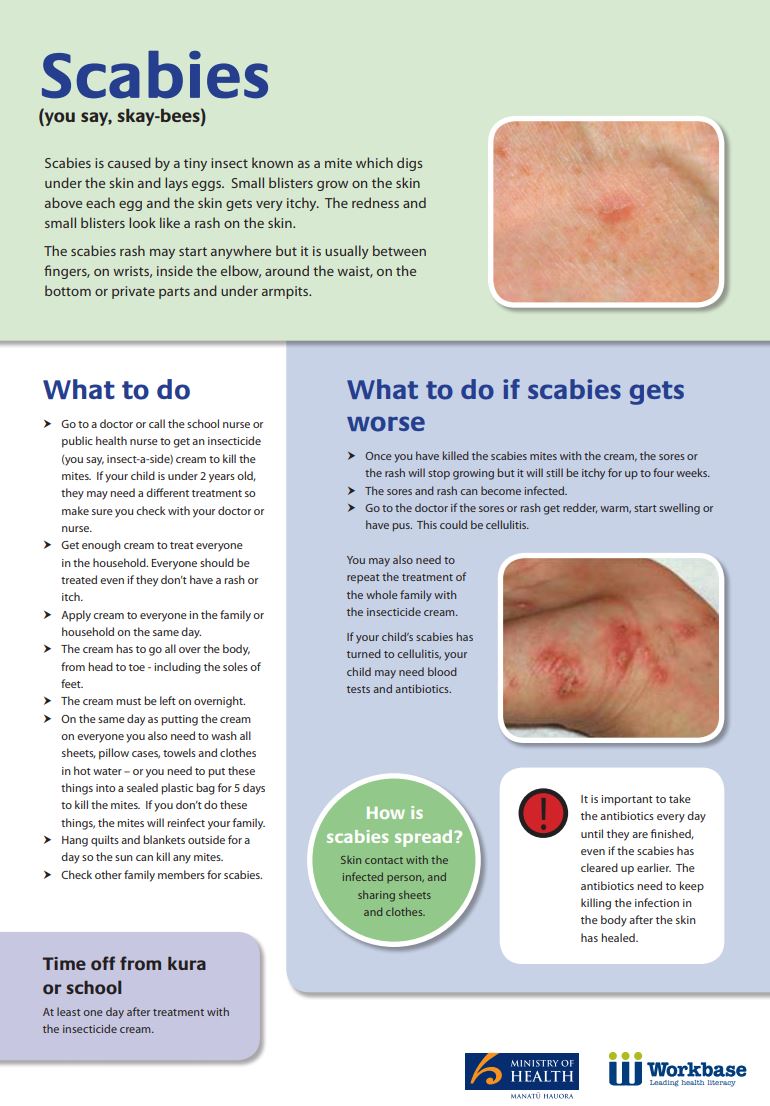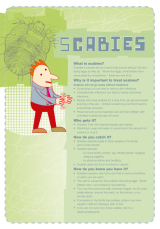Permethrin for scabies
Permethrin is also called A-Scabies lotion.
Key points about permethrin for scabies
- Permethrin is used for the treatment of scabies. Scabies won’t go away without treatment.
- Scabies is highly contagious so everyone in the house must be treated at the same time, even if they are not itchy.
- Apply permethrin properly all over the body and not just to the itchy areas.
- Repeat this treatment after 7 days to make sure the infection does not come back.
- Don’t apply permethrin more than twice without medical advice. Overuse can irritate the skin.

Permethrin is the treatment of choice in New Zealand for scabies because it is very effective in killing the scabies mite. Scabies is a very itchy skin rash mostly in the webs of your fingers and toes. The skin rash is caused by an allergic reaction to a tiny insect (called a mite) which burrows under your skin. Permethrin kills the scabies mite and prevents it spreading. Read more about scabies.
Scabies won’t go away without treatment. It is highly contagious and spreads very easily so everyone in the house must be treated at the same time, even if they are not itchy. It is important to apply permethrin properly all over the body and not just to the itchy areas. See below: How to apply permethrin. Repeat this treatment after 7 days to treat any newly hatched larvae and to make sure the infection doesn't come back.
Note: Permethrin kills the scabies mite preventing its spread but it doesn't relieve the itching. The itching is caused by an allergic reaction to the scabies mite and can continue for up to 4 weeks after treatment. Ask your doctor or pharmacist about medicines to relieve itching. Read more about the scabies itching.
Availability in New Zealand
In New Zealand, permethrin is available on prescription from your doctor or can be bought from your pharmacy without a prescription. It is available as A-Scabies lotion.
Although permethrin can be bought from a pharmacy without a prescription, it's important to talk to your healthcare provider if your child is younger than 2 years old.
Also see your doctor for advice before treatment if you:
- have open wounds or skin infections
- have crusted scabies (severe infestation)
- are bed-bound.
How much permethrin to apply
Permethrin must be applied to every patch of skin over the whole body, from head to toe, including the scalp, face, neck, ears down to the soles of the feet, so it's important to ensure you have enough. Here is some guidance.
- Adults: For each application, 1 bottle of permethrin is usually enough for an average adult, but larger adults may need 2 bottles.
- Children/tamariki aged 5 to 12 years may only need half a bottle and younger children 2 to 5 years, a quarter of a bottle. Ask your doctor about children under 2 years old.
- Second application: A second application of permethrin treatment is needed 7 days later to treat any newly hatched larvae. Don’t apply more than twice without medical advice. Overuse can irritate the skin.
Apply permethrin to the whole body
Apply permethrin when your skin is cool and dry, so if you have just had a bath or shower, wait for a little while to let your skin cool before applying it.
Apply permethrin to every patch of skin over the whole body, from head to toe, including the scalp, face, neck, ears down to the soles of the feet.
- Apply to the areas between the fingers and toes, wrists, armpits, belly button, genitals and buttocks.
- Apply under the finger and toenails – use a nail brush if necessary.
- Women also need to apply permethrin under the breasts and around the nipples, as the scabies mite can burrow into these areas as well.
- If it's easier, you can ask someone else to apply the lotion for you to make sure your whole body is covered.
- Avoid any broken skin, such as cuts, grazes or sores, or skin that has an infection.
- Be careful not to get it in your eyes. If it does get into your eyes, quickly rinse it out with plenty of water.
Leave permethrin on the body for 8 to 12 hours
- To kill the scabies mite, it's important that the permethrin lotion is left on the body for 8 to 12 hours and not washed off. It's best to apply it just before going to bed and leave it on overnight. Wash it off in the morning and wear clean clothes.
- Don't wash your hands after applying the treatment. If you wash part of your body (eg, your hands) within 8 hours of applying permethrin, you will need to re-apply it immediately.
To stop scabies from spreading
- Treat everyone in the same household/whare: Scabies is contagious and spreads to others through close contact. It's important that everyone is treated at the same time as the infested person – even if they are not itchy. This is because they may be carrying the scabies mite.
- Thoroughly clean all personal items and living spaces. On the morning after everyone in your household has been treated, wash all clothing, sheets, towels, pillowcases and stuffed toys anyone has used in the past week in hot water. Read more about cleaning personal items and living spaces.
If you are pregnant, talk to your lead maternity carer or doctor for advice. If you are breastfeeding, wash the permethrin from your nipples before you breastfeed, and then re-apply afterwards.
You or your child can go back to work or school 24 hours after the first treatment with permethrin.
Permethrin can cause skin irritation such as burning, stinging or tingling, numbness, redness and swelling. This should settle after a few hours. If it continues to bother you, tell your doctor or pharmacist.
See your doctor if:
- you are still feeling itchy 6 weeks after finishing the treatment
- you think the scratched areas have become infected.
Read more about medicines and side effects and reporting a reaction you think might be a side effect.
References
- Permethrin(external link) New Zealand Formulary
Brochures

Workbase Education Trust and Ministry of Health, NZ, 2013

Medicines and side effects
Healthify He Puna Waiora, NZ, 2024
Credits: Sandra Ponen, Pharmacist, Healthify He Puna Waiora. Healthify is brought to you by Health Navigator Charitable Trust.
Reviewed by: Angela Lambie, Pharmacist, Auckland
Last reviewed:
Page last updated:






